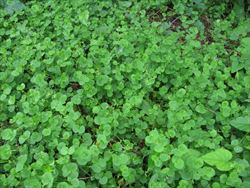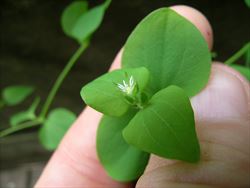- Widespread. In Australia, Fiji, French Polynesia New Caledonia, PNG.
- Aggressive, creeping weed of vegetables, root crops, pastures, lawns, roadsides, riverbanks, forest margins, secondary forests, and plantations. High seed production, fast development, and tolerant of many soil types. A threat to native vegetation.
- Smooth, weak, creeping stems, up to 1m, branching, rooting at nodes. Leaves round/heart-shaped, in opposite pairs, on short stalks. Flowers white, stalks 3-5mm long, at ends of forked stems, and in leaf axils. Five petals, deeply lobed, with sepals beneath. Flattish seeds.
- Spread: vegetatively on creeping stems that root; seed via wind and water; a contaminant of hay, and on vehicles and livestock. Long distance from its use as a food and in traditional medicines.
- Biosecurity: risk is seed as a contaminant of other species. Check imported machinery/vehicles. Check hay. Available on Internet.
- Biocontrol: none.
- Cultural control: hand-weed; slashing (but stem pieces regrow) – cultivation in pastures more effective in dry season. Mulch (5-10cm) to prevent seedling growth. Clean soil and seed from machinery/vehicles. Ensure hay is free from tropical chickweed.
- Chemical control: in Australia, napropamide; cyanazine; dicamba; metribuzin; oxyfluorfen; terbutryn. In Fiji, glyphosate; dicamba and 2,4-D.








